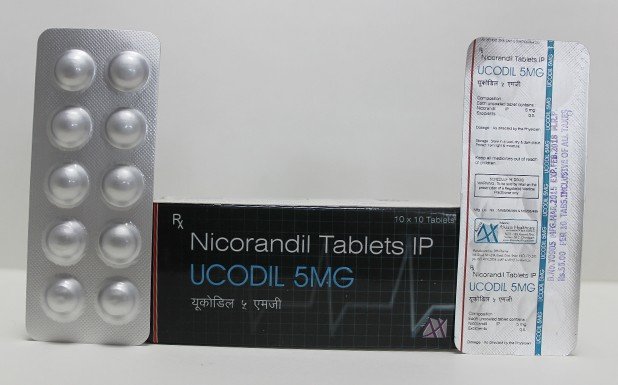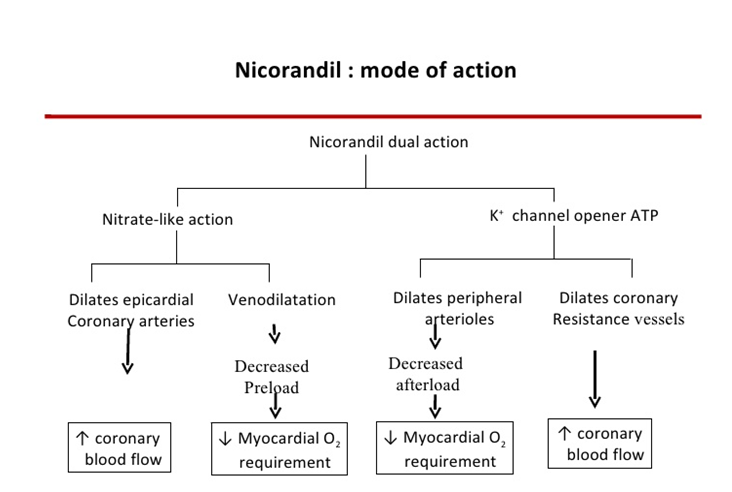
Composition
- Each Uncoated tablet Contains:
- Nicorandil IP
5 mg
Packing
- 10x10
(Alu-Alu)
MRP
- 55
Overview
Nicorandil contains a substance called nicorandil. This substance belongs to a group of medicines called "potassium channel activators". It works by relaxing blood vessels and increasing the blood flow and oxygen supply to the heart. Nicorandil is used to prevent chest pain (angina pectoris) and for long-term treatment of chest pain (stable angina pectoris).
WHAT IS UCODIL AND WHAT IT IS USED FOR?
Angina is a pain that comes from the heart. It is usually caused by the narrowing of one or more of the arteries that supply blood to your heart. This narrowing reduces the blood supply to parts of your heart muscle. When your heart needs more blood and oxygen than can get through the narrowed arteries (for example, when you walk fast or climb stairs), you feel angina pain.Nicorandil works by relaxing (widening) your blood vessels. This increases the supply of blood and oxygen to your heart, and reduces the pain you feel. It can also reduce the risk of further heart conditions.
Why is this medication prescribed?
Nicorandil belongs to a group of medicines called 'potassium channel activators'. It works by increasing the blood flow through the blood vessels of the heart. Nicorandil is used to stop and treat long-term chest pain (angina).Warnings
Do not take Nicorandil:
If you are allergic (hypersensitive) to nicorandil or any of the other ingredients in this medicine. Signs of allergic reaction include: a rash, swallowing or breathing problems, swelling of your lips, face, throat or tongue.
If you have any heart conditions such as a low blood output from the heart or if you have suffered from heart failure.
If you have low blood pressure.
If you are using medicines for treating impotence such as sildenafil, tadalafil and vardenafil.
Contraindications
Nicorandil and Pregnancy
USFDA pregnancy category B. Nicorandil may not cause harm to an unborn foetus. Before Nicorandil treatment, the patient should discuss with the physician, if they are planning for a pregnancy.Nicorandil and Lactation
It is unclear whether the drug could pass through the breast milk to a breast feeding baby. Consult your physician before taking Nicorandil, if you are nursing mother.Nicorandil and Children
Nicorandil is contraindicated in children.Nicorandil and Other Contraindications
Cardiogenic shock; hypotension; left ventricular failure with low filling pressure; lactation.Side Effects
Like all medicines, Nicorandil can cause side effects, although not everybody gets them. If you experience the following, stop taking this medicine and tell your doctor immediately:
Red and lumpy skin rash, swollen eyelids, face, lips, mouth or tongue, itching, difficulty in breathing or swallowing. This could be an allergic reaction (angioedema). Yellowing of skin or eyes (which may be signs of liver problems). Increased or fast heart-beat.
Dosage
This is Preferred Dosage:
Start with initial oral dose of 5 mg of Nicorandil, twice daily. The usual recommended dose of Nicorandil is 10-20 mg, twice daily. The maximum dose should not exceed 30 mg twice daily.
Disclaimer:To be taken only after consulting with the doctor.
Storage
Store it at room temperature.
Pharmacology
Mechanism of Action
Nicorandil, a vasodilator, is prescribed for the treatment and management of angina pectoris. The drug relaxes the blood vessels and alleviates the angina.Pharmacodynamics
Nicorandil mediates vasodilatation by opening of potassium channels by stimulation of guanylate cyclase. Nicorandil significantly reduce preload and afterload of cardiovascular physiology and thereby improves coronary blood flow.Pharmacokinetics
Nicorandil dilates arterioles and large coronary arteries by opening the potassium channels, and stimulates guanylate cyclase causing venous vasodilatation. It therefore reduces preload and afterload, and improves coronary blood flow.Absorption: Absorbed well from the GI tract (oral); peak plasma concentrations after 30-60 min.
Distribution: Protein-binding: Slightly bound.
Metabolism: Denitration
Excretion: Via urine (as metabolites); 1 hour (elimination half-life).

Interactions
Nicorandil may interact with anti-hypertensive drugs, vasodilators, tricyclic anti-depressants, PDE-5 inhibitors such as Sildenafil citrate.
Other Interactions: Do not consume alcohol while taking Nicorandil.
For Patients
Always take nicorandil exactly as your doctor has told you. You should check with your doctor or pharmacist if you are not sure. You should not take the tablets, which are included in the pack to protect nicorandil tablets from moisture. If you do accidentally take any of these tablets, they should not harm you, but you should tell you doctor straight away. Taking this medicine:
- Take this medicine by mouth.
- Swallow the tablets whole with a drink of water. D o not crush or chew the tablets.
- If you feel the effect of your medicine is to o weak or too strong, do not change the dose yourself, but ask your doctor.
Chemistry
Nicorandil
Synonyms N-[2-(Nitroxy)ethyl]-3-pyridinecarboxamide
Molecular Structure 
Molecular Weight 211.18
Clinical Data
Pregnancy Category | AU: B3 |
Legal status | UK: POM |
Routes | Oral |